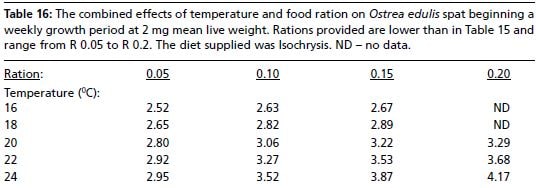6.5.3 Combined effects of ration and temperature
The effects of growing, for example, European flat oyster spat on different rations each at a range of temperatures are shown in Table 16. These data were calculated from similar growth curves to those shown in Figure 100 and apply to spat beginning a weekly growth period at 2 mg mean live weight.
Table 16: The combined effects of temperature and food ration on Ostrea edulis spat beginning a weekly growth period at 2 mg mean live weight. Rations provided are lower than in Table 15 and range from R 0.05 to R 0.2. The diet supplied was Isochrysis. ND – no data.

The lowest ration tested (R 0.05) was still adequate to support growth at the highest temperature although growth rate at this ration was declining rapidly as temperature increased.
Food supply must be sufficient to support metabolism, the rate of which increases as the temperature rises, with energy remaining for growth. Low food rations at high temperatures result in spat that may increase in size in terms of shell growth but at the expense of the soft body. Spat that leave the hatchery in poor condition are more likely to die during early growout. Much information exists in the literature and the reader is directed to the suggested reading at the end of Part 6 to pursue this topic further.